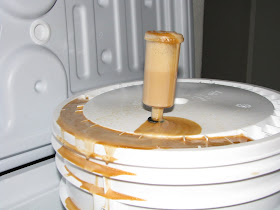I had mentioned adding some Brettanomyces Claussenii to it to drop the gravity and maybe even turn it into a sour beer, after all ESB, Browns, and Milds make great base beers for sours.
Fast forward a month or so, and TheSanch and I had discussed trying an experiment with Brett C., which quickly turned into an experiment involving Brett C., Lactobacillus delbrueckii bacteria, and Belgian Sour Mix I (Includes Brettanomyces, Saccharomyces, and the bacterial strains Lactobacillus and Pediococcus.)
The ESB had been kegged and fully carbed before the experiment began, luckily Lactobacillus, and Pediococcus do not require oxygen, however Brett C. does, although at a much lower level than Saccharomyces C.
The kegged ESB had been brought up to room temperature and the co2 bled off daily until very litte was still coming out of solution.
Yesterday I managed to finally start the experiment. I ended up purchasing White Labs Brett C., Lactobacillus delbrueckii, and Belgian Sour Mix I. I was hoping to also use some Pediococcus bacteria alone, but our local homebrew store was out at the time.
The experiment was originally going to be conducted in three 1 gallon growlers and the remaining beer was going to be placed into a 5 gallon Better Bottle. Each of the three 1 gallon containers were to be inoculated with the bacteria and yeast, and the fourth would have a portion of all three added. It seemed redundant to have the fourth container since the Belgian Sour Mix had both Brett and Lacto included already, the only difference was the Pedio. After putting some thought into it, I wasn't ready to designate one of my plastic carboys to solely making sour beers anyhow.
First was to get the beer out of the keg and into the growlers. This was achieved with a picnic faucet and a section of broken racking cane that came in handy for the transfer.
As you can see there is no foam, the beer was realatively flat. I used about 3psi to force it out of the keg.
After all three growlers were filled it was time to inoculate them.
The deed was done.
...and voila!
Since the ESB had been carbed and some co2 is still slowly escaping from solution, I went with foil caps rather than airlocks. Although the Lacto only growler doesn't require any oxygen, the Brett C., and Belgian Sour Mix I growlers do have yeasts that require oxygen, albeit lower levels than Saccharomyces C. I think the foil caps will aid in gas exchange, hence the reason I used the foil opposed to airlocks.
Looking back I used an entire White Labs vial per gallon, so there should definitely be enough bacteria and yeast in each fermenter to ensure fermentation, the only concern I have is the Brett C. and the lack of oxygen dissolved in the beer, I'm keeping my fingers crossed that the foil cap will allow the gas exchange necessary for the Brett C. to get a foot hold and work it's magic.
Sour fermentations are generally slow, and depending on how sour you want the beer can have a large impact on how long the beer will be allowed ferment.
I'm looking forward to seeing my first pellicle form. I also wonder what each will taste like, and once they are soured if blending them will achieve a better result, only time will tell. Either way I will update on this experimental project when there is something to update, which might take some time. Until then, Cheers!










